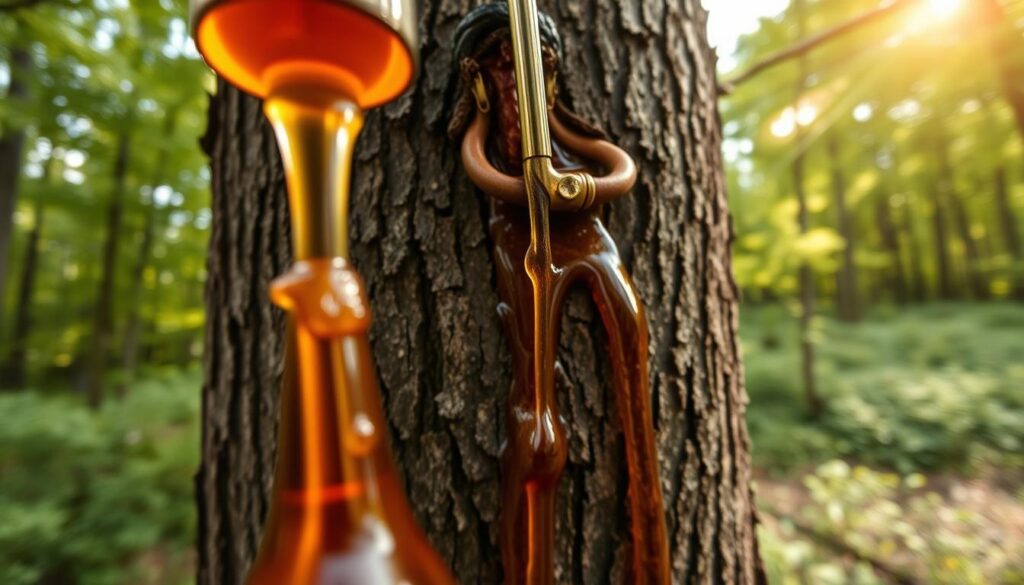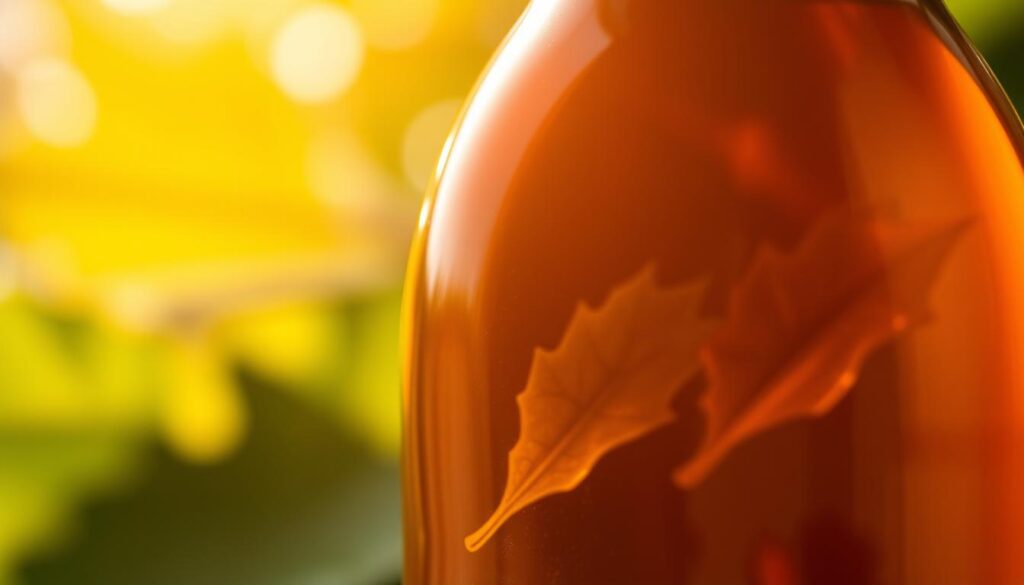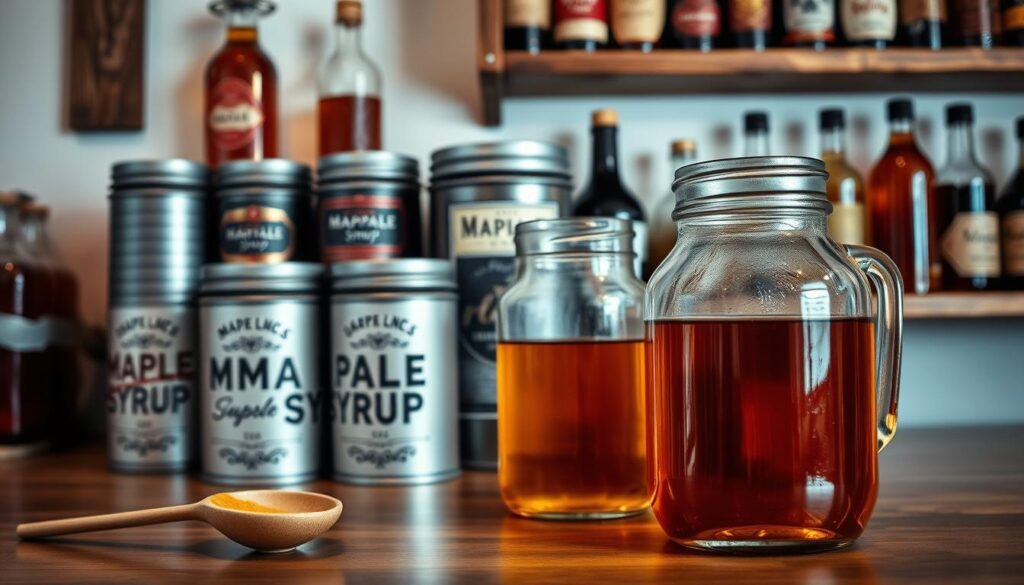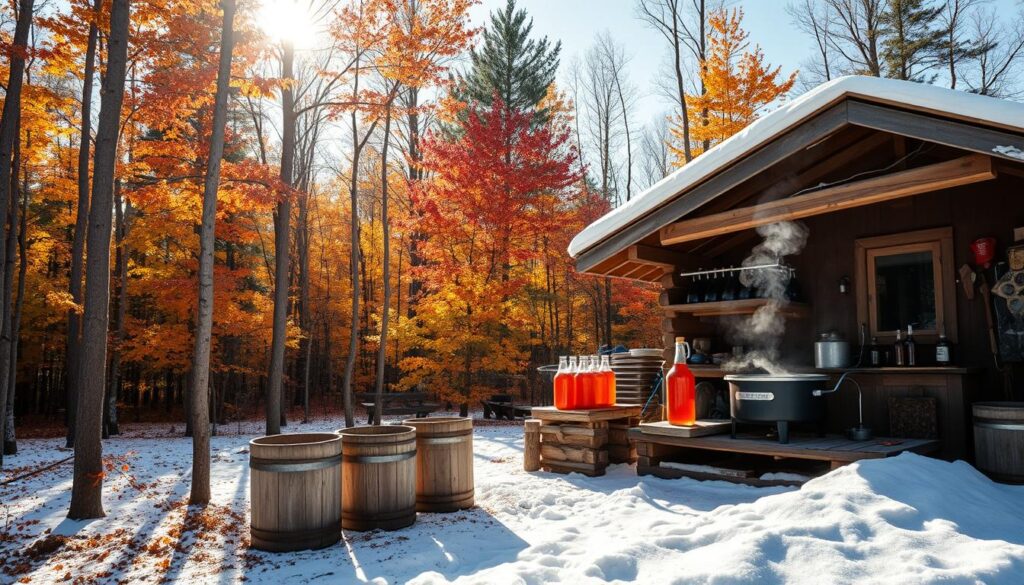Maple syrup is a special natural sweetener with deep roots in North American cooking. It’s more than just a breakfast topping; it shows the bond between nature and human skill. Learning about maple syrup, you’ll see how it turns tree sap into a tasty treat.
Maple syrup comes from the maple trees of northeastern North America, like Vermont and Quebec. It’s made by tapping sugar maple trees at the right time. This process collects the sap that flows inside the tree.
To make maple syrup, sap is boiled down to concentrate its sugars. It takes about 40 gallons of sap to get one gallon of syrup. This hard work shows the value and skill in every bottle of maple syrup.
Different maple trees can make syrup, but sugar maples are the main ones. Their special cells make it easy to collect sap in early spring. Sugarmakers watch the weather and tree health to harvest sustainably.
Maple syrup is not just sweet; it’s also full of minerals like manganese and zinc. Its flavor can be light or strong, making it great for cooking and baking.
What Is Maple Syrup: Understanding Nature’s Sweetener
Pure maple syrup is a natural sweetener that comes from maple trees. It’s made through a detailed process that turns tree sap into a golden syrup. This syrup is loved for its unique taste and health benefits.
The magic of maple syrup starts with the science of maple trees. They can produce a lot of sap, which is key to making syrup.
The Science Behind Maple Sap
Maple trees store starch in their roots and trunks during winter. This starch turns to sugar in early spring. This natural process makes the sweet liquid that becomes maple syrup.
The sap’s production depends on:
- Temperature changes between cold nights and warm days
- The tree’s age and health
- The season’s weather
From Tree to Table Process
Maple syrup production has several steps to turn raw sap into a tasty sweetener:
- Tapping maple trees in early spring
- Collecting raw sap with special tubing systems
- Boiling sap to reduce water content
- Filtering and bottling the syrup
Natural Sugar Components
Pure maple syrup is more than just sugar. It has natural minerals and antioxidants, unlike refined sugars.
| Sugar Component | Percentage |
|---|---|
| Sucrose | 62-67% |
| Water | 33% |
| Minerals | 1-3% |
Maple syrup production is an art form. It turns nature’s simplest resources into a complex, flavorful sweetener. This connects us to traditional farming practices.
The Rich History of Maple Syrup Production
Maple syrup production has its roots in North American indigenous cultures. Native American tribes first found the sweet sap of maple trees. They developed complex ways to harvest it before European settlers came.
The history of maple syrup is filled with cultural innovation. Indigenous peoples used wooden tools and bark containers to collect sap. They made cuts in trees, letting sap drip into containers. Then, they warmed the sap with heated stones to make syrup.
- Early maple syrup production used primitive but ingenious methods
- Seasonal harvesting was critical to indigenous maple syrup techniques
- Traditional knowledge transferred through generations of sugarmakers
European settlers learned from indigenous communities. By the 1700s, they had metal tools and big processing methods. They used metal buckets and better boiling techniques.
The 19th century brought big changes to maple syrup production. New technologies like evaporators and understanding trees helped. Maple syrup became a commercial product, important for local economies.
Maple syrup: A sweet testament to human ingenuity and connection with nature.
Traditional vs Modern Maple Syrup Making Methods
The art of making maple syrup has changed a lot over time. It mixes old traditions with new technology. This journey shows how tradition and progress can meet.
Indigenous Harvesting Techniques
Native American tribes started making maple syrup long ago. Their traditional methods were amazing. They showed respect for the forest:
- Cutting V-shaped bark incisions to collect sap
- Using wooden spiles crafted from local trees
- Boiling sap in clay and bark containers
- Harvesting during specific seasonal windows
Contemporary Production Technology
Now, making maple syrup is different. New technology has made it faster and more accurate.
- Vacuum-assisted sap collection systems
- Digital monitoring of tree health
- Reverse osmosis equipment for rapid concentration
- Automated evaporation technology
Sustainable Practices
Today, making maple syrup is all about caring for the environment. New methods help keep the forest healthy:
- Selective tree tapping to prevent damage
- Implementing regenerative forestry practices
- Using renewable energy in processing
- Maintaining forest biodiversity
“Maple syrup production is a delicate dance between tradition and innovation” – Northeast Forest Conservancy
Identifying Pure Maple Syrup Sources

Finding real pure maple syrup needs careful choice and knowing what to look for. People looking for the best should learn how to spot quality products.
When looking for pure maple syrup, check the labels and ingredients. True pure maple syrup has just one thing: maple sap from maple trees. Stay away from syrups with corn syrup, fake flavors, or extra sugars.
- Check for USDA-certified organic labels
- Look for single-ingredient maple syrup packaging
- Verify the syrup’s origin from reputable maple-producing regions
- Confirm the producer’s credentials and harvesting practices
Maple syrup facts show that real syrup comes from sugar maple tree sap. Places like Vermont, New York, and Quebec are known for their top maple syrup. Small producers usually make better syrup than big companies.
Knowing how to tell real maple syrup apart is key. It’s clear and has a deep amber color. It’s smooth too. Fake syrups are uniform and lack the real stuff’s depth.
“True maple syrup is nature’s liquid gold, capturing the essence of maple trees in every drop.” – Maple Syrup Producers Association
Buying from local farmers markets, specialty stores, or maple farms gets you the best syrup. Online stores also offer great maple syrup from trusted makers.
Different Grades of Maple Syrup Explained
Maple syrup comes in many flavors. It’s sorted into grades based on color, taste, and when it’s picked. Knowing about maple syrup grades helps cooks pick the right syrup for their recipes.
Maple syrup makers follow a set grading system. This system shows the syrup’s special qualities. It lets buyers choose from a variety of syrups.
Grade A Light Amber
Light Amber is the lightest syrup grade. It’s picked early, so it’s very sweet but not too strong. Chefs love it for adding a touch of sweetness without overpowering dishes.
- Lightest color in maple syrup grades
- Subtle, refined taste
- Perfect for drizzling on pancakes
- Ideal for baking delicate pastries
Grade A Medium Amber
Medium Amber has a richer taste than Light Amber. It’s picked mid-season. This syrup has a strong maple flavor that’s balanced with sweetness.
- Deeper color than Light Amber
- More robust maple flavor
- Versatile for cooking and baking
- Excellent for glazes and marinades
Grade A Dark Amber
Dark Amber is the darkest syrup grade. It’s picked late, so it’s very rich and bold. Maple fans love it for its deep color and strong taste.
“Dark Amber maple syrup captures the true essence of maple’s natural complexity” – Maple Syrup Producers Association
- Darkest standard maple syrup grade
- Strong, pronounced maple flavor
- Best for robust recipes
- Ideal for barbecue sauces and hearty desserts
Essential Nutritional Benefits and Properties

Maple syrup is more than a sweet treat. It has many nutritional benefits that make it a unique natural sweetener. Unlike refined sugars, maple syrup has essential nutrients that are good for our health.
Looking into maple syrup facts shows its impressive nutritional profile. This natural sweetener has valuable compounds that make it different from other sugars:
- Rich in antioxidants that help combat cellular damage
- Contains trace minerals like manganese and zinc
- Provides small amounts of calcium and potassium
- Lower glycemic index compared to regular sugar
The nutritional makeup of maple syrup makes it a great alternative to processed sweeteners. While it should be consumed in moderation, maple syrup offers more than just calories.
| Nutrient | Amount per 100g | Key Benefits |
|---|---|---|
| Manganese | 33% Daily Value | Supports bone health and metabolism |
| Zinc | 3.7% Daily Value | Boosts immune system |
| Calcium | 2% Daily Value | Promotes bone strength |
“Nature’s sweetener offers more than just taste – it’s a nutrient-rich alternative to processed sugars.” – Nutritional Research Institute
Nutritionists suggest using maple syrup sparingly in a balanced diet. Its natural origins and minimal processing make it a more nutritious sweetener than refined sugar alternatives.
Common Uses in Cooking and Baking
Maple syrup is more than just a pancake topping. Its rich flavor makes it great for many recipes. It turns simple meals into special dishes.
Maple syrup’s unique taste lets cooks get creative. It can make your cooking and baking better.
Breakfast Delights
Maple syrup makes breakfast exciting. It’s not just for pancakes and waffles. It can be used in many morning dishes.
- Maple-glazed bacon
- Overnight oatmeal with maple drizzle
- Maple-infused smoothies
- Baked French toast with maple custard
Decadent Dessert Recipes
Dessert lovers can make classic treats better with maple syrup. It adds depth and sweetness to many desserts.
- Maple pecan pie
- Maple cream brulee
- Maple walnut ice cream
- Maple-glazed apple tart
Unexpected Savory Dishes
Maple syrup is great in savory dishes too. It adds a unique twist to main courses and sides.
| Dish Category | Maple Syrup Application |
|---|---|
| Meat Glazes | Maple-bourbon chicken |
| Vegetable Sides | Roasted Brussels sprouts with maple |
| Salad Dressings | Maple-mustard vinaigrette |
Exploring maple syrup’s uses can open up new culinary possibilities. It’s perfect for breakfast, desserts, and savory dishes. It adds a special flavor to any meal.
Storing and Preserving Maple Syrup
Pure maple syrup needs careful storage to keep its quality and flavor. Knowing how to store it right makes it stay fresh and tasty for a long time.

Maple syrup facts show that storing it right is key. To keep pure maple syrup at its best, follow these steps:
- Store in a cool, dark place before opening
- Refrigerate after opening to prevent spoilage
- Use clean, airtight containers
- Check for signs of mold or fermentation
Temperature is very important for keeping maple syrup good. Ideal storage conditions range between 32°F and 40°F. This keeps the syrup from getting too thick and keeps its natural sweetness.
| Storage Location | Duration | Recommended Conditions |
|---|---|---|
| Pantry (Unopened) | 1 year | Cool, dark place |
| Refrigerator (Opened) | 1-2 years | Sealed container |
| Freezer | Indefinite | Leave space for expansion |
Freezing maple syrup is a great way to store it for a long time. When stored right, maple syrup can stay good for years. Always check the syrup before using it, throwing away any with mold or bad smells.
Pro tip: If crystallization occurs, gently warm the syrup to restore its smooth consistency.
Maple Syrup vs Other Natural Sweeteners
Understanding what is maple syrup means exploring its unique position among natural sweeteners. Consumers seeking healthier alternatives are increasingly comparing maple syrup with other sweetening options to maximize nutritional benefits.
Natural sweeteners offer diverse characteristics that impact flavor, nutrition, and culinary applications. The benefits of maple syrup extend beyond simple sweetness, making it a standout choice for health-conscious individuals.
Comparing Maple Syrup and Honey
Maple syrup and honey represent two prominent natural sweeteners with distinct profiles:
| Characteristic | Maple Syrup | Honey |
|---|---|---|
| Origin | Tree Sap | Bee Nectar |
| Glycemic Index | 54 | 58 |
| Mineral Content | Higher | Lower |
| Flavor Complexity | Rich, Woody | Floral, Varied |
Alternative Sugar Substitutes
When exploring natural sweeteners, maple syrup stands out with its unique nutritional profile:
- Contains more antioxidants than agave
- Lower glycemic impact compared to coconut sugar
- More complex flavor than stevia
Maple syrup provides a nutrient-dense alternative to refined sugars, with both sweetness and health benefits.
Seasonal Harvesting and Best Times to Buy
Maple syrup making is closely tied to the seasons. It happens from late winter to early spring. This is a short but key time for syrup makers in North America.
The sap flows best when it’s cold at night and warm during the day. This mix of temperatures makes the sap move in the trees.
- Peak maple syrup production season: Late February to early April
- Optimal temperature range for sap flow: 40-45°F during day, below 32°F at night
- Average harvesting period: 4-6 weeks per year
Climate change affects maple syrup making. Warmer winters and changing temperatures can lower sap yield and quality.
| Month | Sap Flow Potentia | Production Likelihood |
|---|---|---|
| February | Low to Moderate | Early Start |
| March | High | Peak Season |
| April | Declining | Late Season |
Buying maple syrup right after it’s made is best. Local farmers markets and specialty stores often have the latest syrup.
It’s best to buy maple syrup in March and May for the freshest taste. Storing it right can keep it good all year.
Understanding Maple Syrup Labels and Certifications
Exploring the world of maple syrup labels can be tricky. Different grades and certifications tell us about the syrup’s quality and where it comes from.
When you’re looking for pure maple syrup, it’s key to understand what the labels mean. The USDA sets rules for maple syrup grades. This helps you choose the right syrup for your needs.
- Grade A Light Amber: Delicate flavor, perfect for drizzling
- Grade A Medium Amber: Richer taste, ideal for baking
- Grade A Dark Amber: Robust flavor, great for cooking
Organic certifications also play a big role. They show the syrup meets high environmental and production standards.
| Certification Type | Key Requirements |
|---|---|
| USDA Organic | No synthetic pesticides, sustainable forest management |
| Non-GMO Project Verified | No genetically modified ingredients in production |
| Fair Trade Certified | Ethical sourcing, fair compensation for producers |
Maple syrup grades tell you about the syrup’s color, taste, and how to use it. Lighter syrups have a milder taste, while darker ones are more intense.
Pro tip: Always check the label for production origin and certification details to ensure you’re getting authentic, high-quality pure maple syrup.
Common Myths and Misconceptions
Many people have wrong ideas about maple syrup. They think it’s not natural or that it’s not good for you. But, the truth is different.
There are many myths about maple syrup that need to be cleared up:
- All maple syrups are the same – False. Different grades have different tastes and colors
- Maple syrup is just sugar – Incorrect. It has minerals and antioxidants that are good for you
- Maple-flavored products are authentic maple syrup – Misleading. Most use fake flavorings
Maple syrup makers work hard to make pure syrup. They tap maple trees at the right time and use special methods to get the sap.
Some think maple syrup is bad because it’s sugar. But, it’s better than regular sugar. It has minerals like zinc, manganese, and calcium.
Pure maple syrup is a natural sweetener with real value for cooking and health.
It’s important to read labels and know the difference between real maple syrup and fake stuff. This helps you make better choices when you shop.
Conclusion
Maple syrup is more than a sweetener; it connects us to old ways of making food. It shows how tree sap turns into a tasty sweetener. This journey from forest to table is truly amazing.
There are many types of maple syrup, each with its own taste and uses. Light amber is great for pancakes, while darker syrups are perfect for baking. Each type has its own story, thanks to the hard work of sugarmakers.
Using maple syrup in cooking can make a big difference. It adds a natural sweetness and nutrition to dishes. It’s perfect for breakfast, savory meals, or baking, giving a unique flavor that sugar can’t match.
As people look for sustainable foods, maple syrup is a top choice. It’s not just a sweetener; it’s a symbol of tradition and quality. Its rich taste and history make it a special ingredient in cooking.



